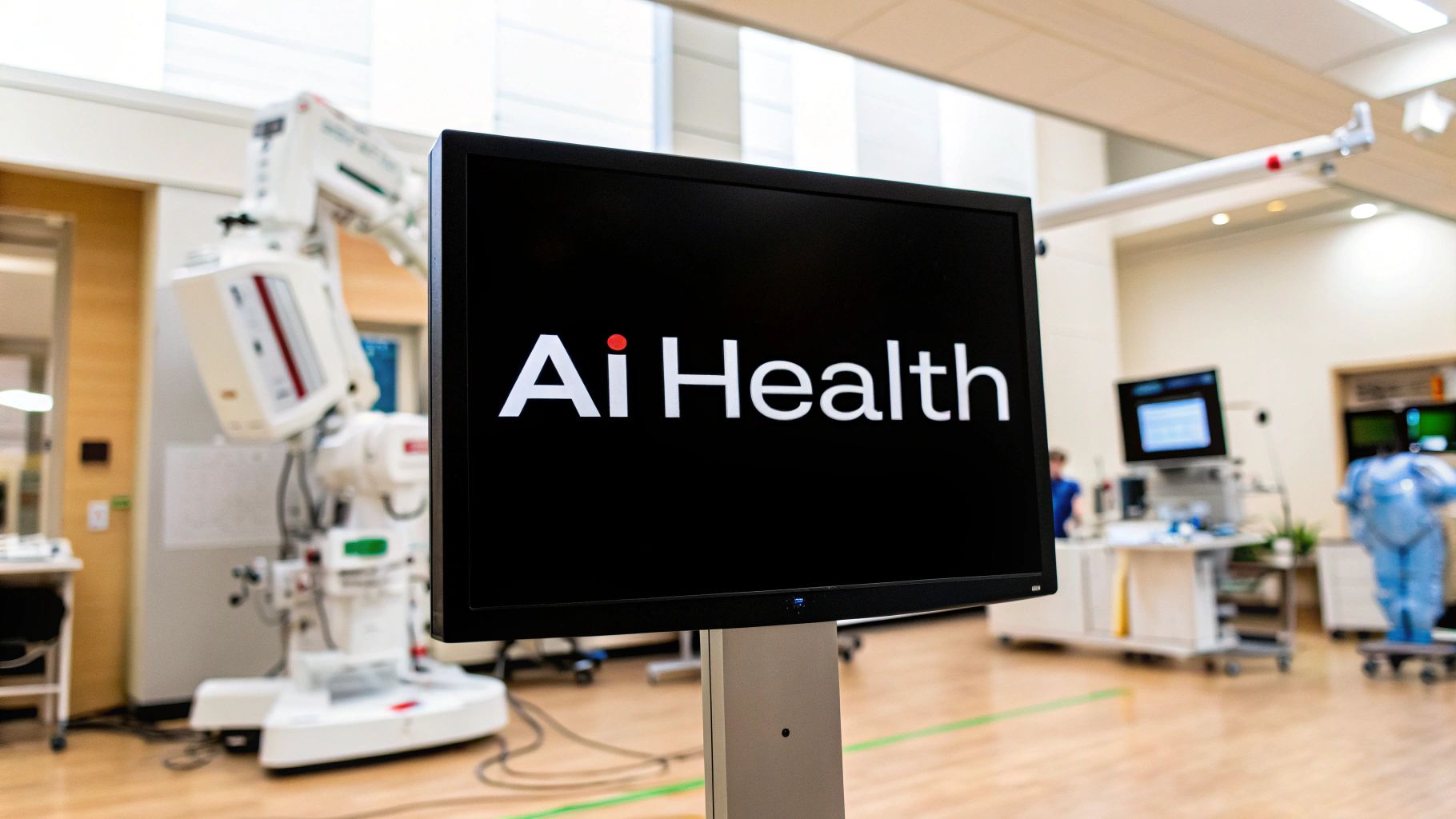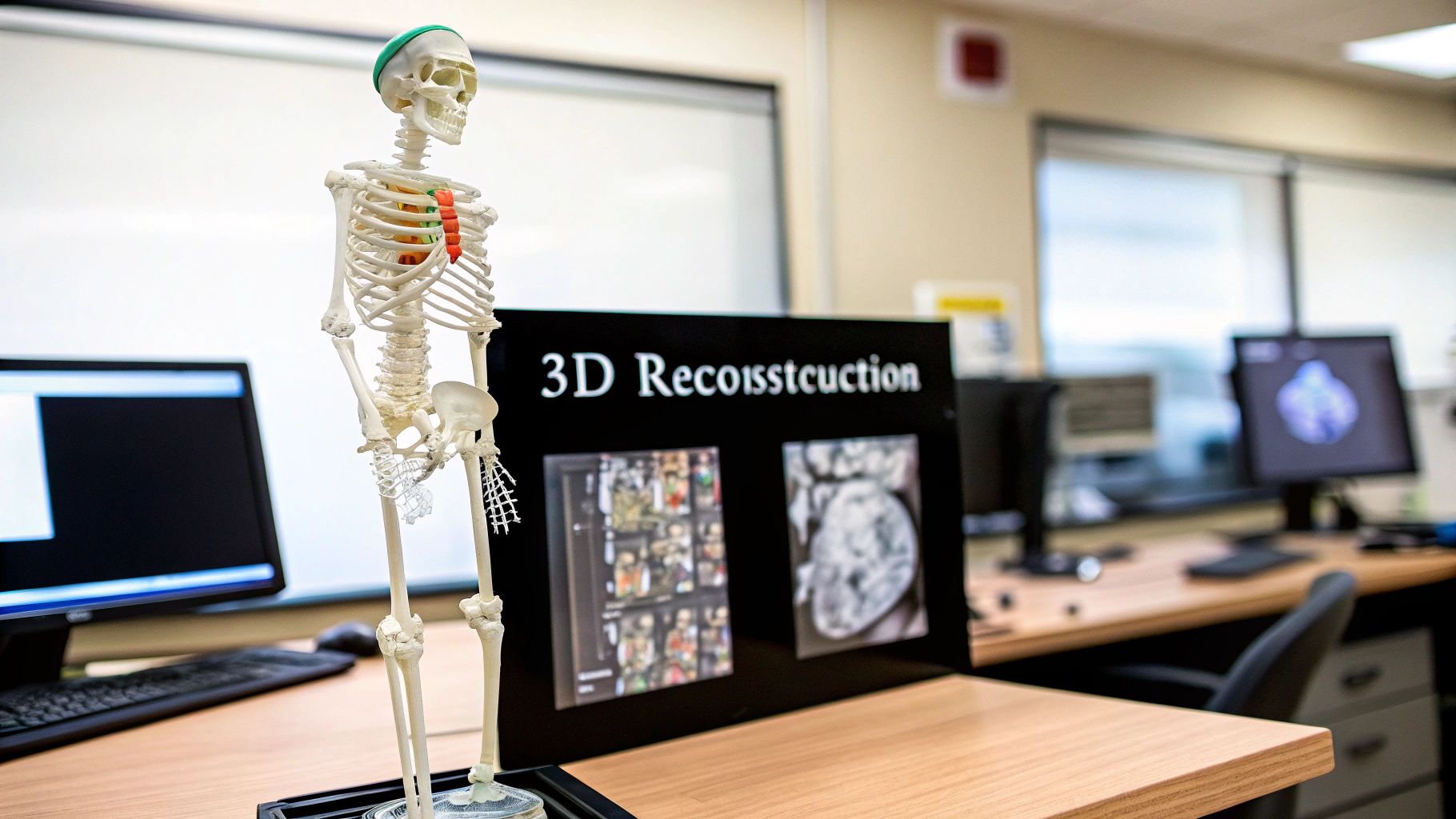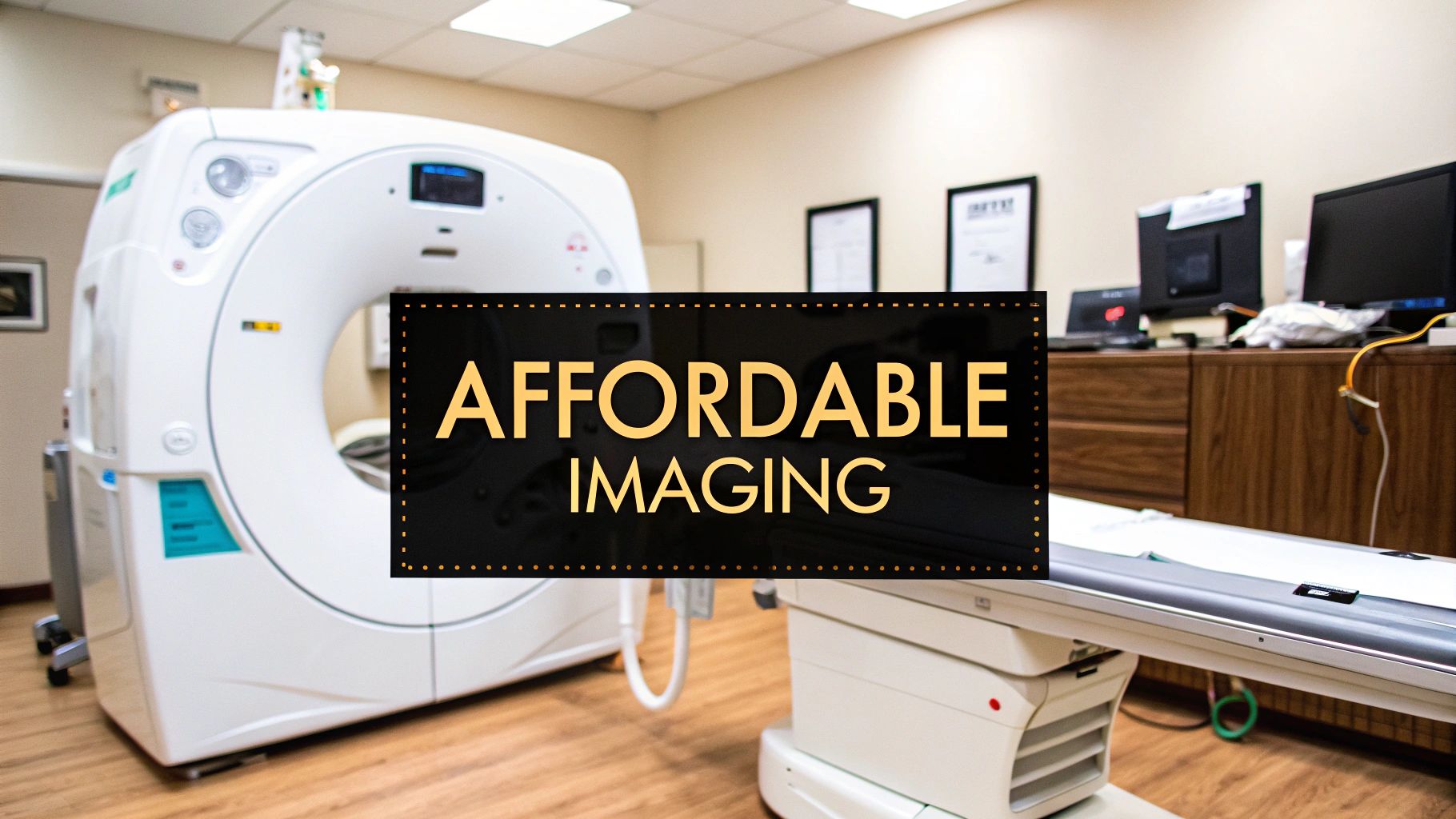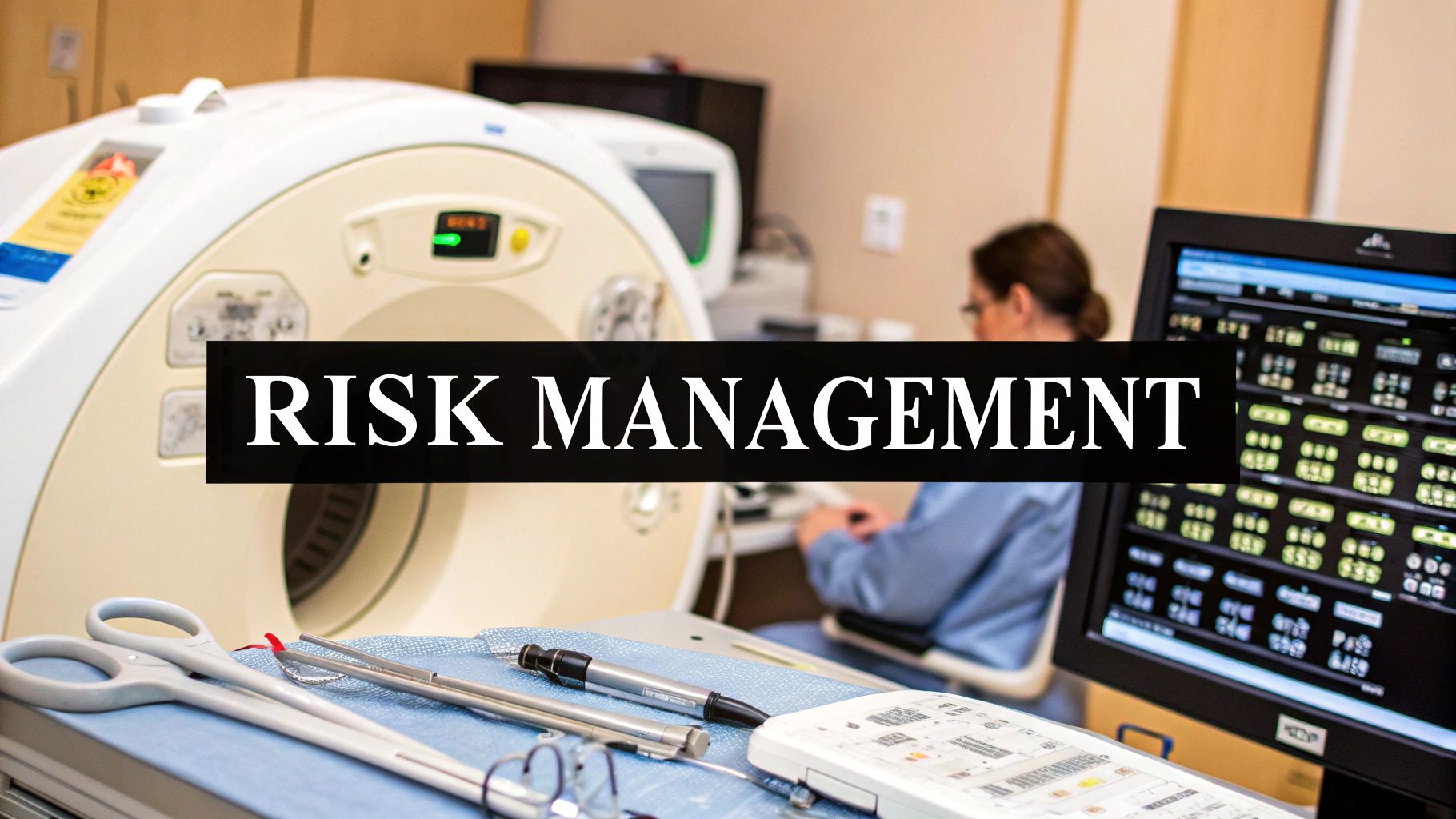The Future of Healthcare is Here: AI-Powered Medical Devices
Artificial intelligence (AI) is transforming healthcare, and this listicle focuses on ten impactful artificial intelligence medical devices. Discover how these tools enhance diagnostics, personalize treatments, and improve patient care. For medical device manufacturers, healthcare technology companies, researchers, and IT professionals, this list provides key insights into innovative AI solutions addressing critical healthcare challenges. From AI-powered diagnostic imaging to portable cardiac monitors, explore the leading artificial intelligence medical devices shaping the future of medicine.
1. PYCAD: Custom AI Powering the Future of Medical Imaging
PYCAD is a leading provider of custom artificial intelligence solutions specifically designed to enhance medical imaging analysis and workflows. Founded in 2023, they bring a wealth of experience in computer vision and medical imaging to the table, offering end-to-end services that cater to a variety of needs within the artificial intelligence medical devices landscape. Whether you're a medical device manufacturer looking to integrate AI into your latest product, a hospital seeking to improve diagnostic accuracy, or a research institution exploring cutting-edge imaging techniques, PYCAD offers tailored solutions designed to empower your work with the transformative power of AI. This makes them a valuable partner for anyone looking to leverage AI in medical imaging, securing their spot on this list. They offer a comprehensive suite of services that encompass data handling, model training, and deployment, ensuring seamless integration of AI into existing medical imaging pipelines. Their focus on client collaboration and leveraging cutting-edge technologies makes them an ideal partner for navigating the complexities of AI in healthcare.
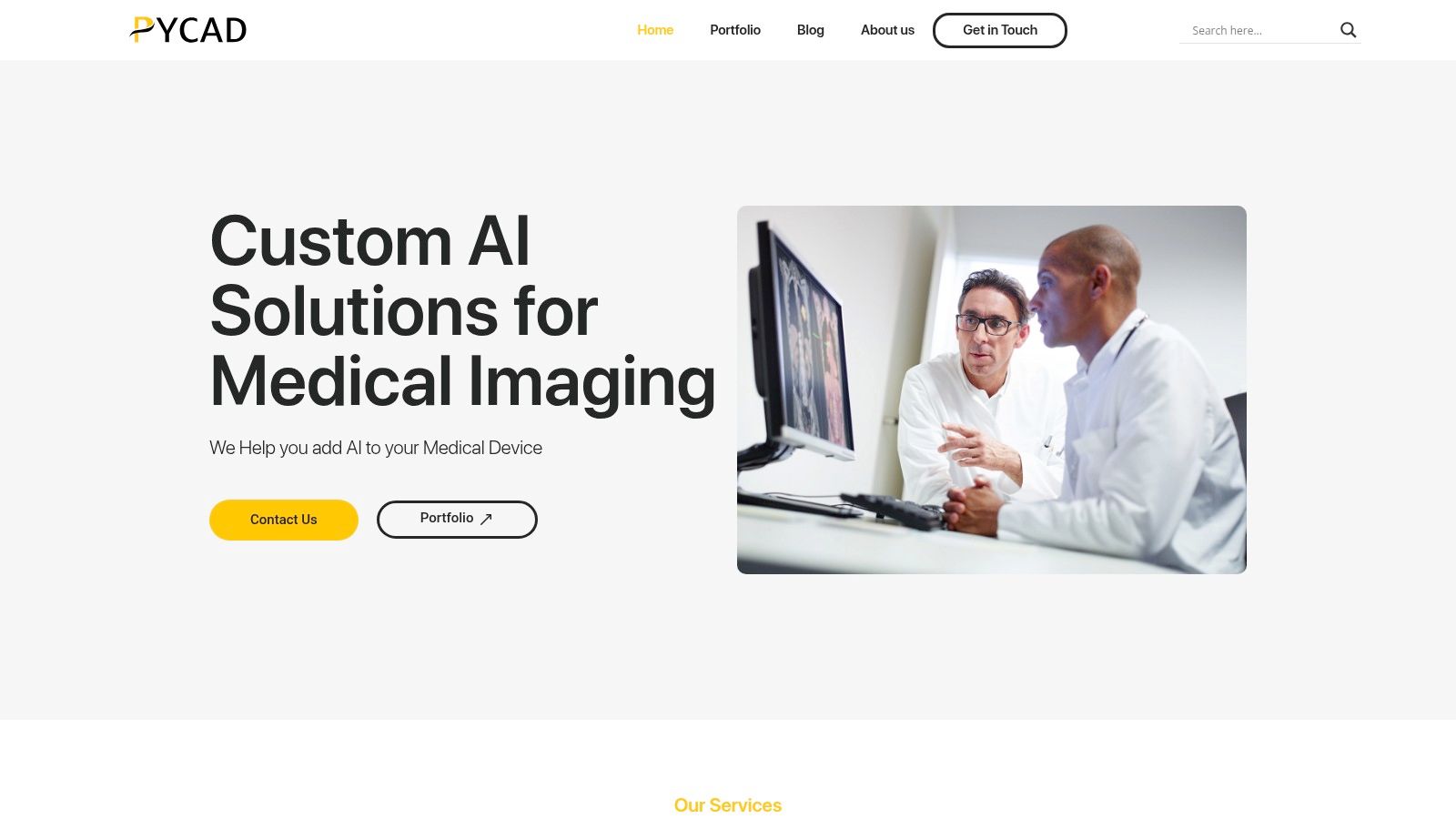
PYCAD's comprehensive suite of services covers the entire lifecycle of an AI project in medical imaging:
- Data Handling: PYCAD assists with the critical aspects of data management, including meticulous annotation guidance, ensuring data quality and consistency for training robust AI models. They also provide data anonymization services, crucial for maintaining patient privacy and complying with regulatory requirements like HIPAA. Furthermore, PYCAD handles the complexities of managing diverse medical image file formats, including DICOM, NIfTI, and others.
- Model Training: PYCAD leverages its expertise to train highly accurate and efficient AI models optimized for specific medical imaging tasks. They work closely with clients to define project requirements and tailor model configurations to achieve optimal performance. This bespoke approach ensures that the AI solutions are precisely aligned with the client's unique needs and goals.
- Model Deployment: PYCAD facilitates seamless integration of trained AI models into existing workflows. They offer flexible deployment options via APIs on cloud platforms like Google Cloud Platform (GCP) and Amazon Web Services (AWS), allowing for scalable and reliable access to AI-powered insights. They also provide development of Minimum Viable Product (MVP) UIs, allowing for quick testing and validation of AI models in real-world clinical settings.
Pros:
- Comprehensive end-to-end AI solutions for medical imaging, covering data handling, model training, and deployment.
- Proven track record with over 10 successful projects and demonstrated expertise in computer vision and medical imaging.
- Customized services tailored to diverse healthcare and medtech audiences, including medical device manufacturers, hospitals, research institutions, and startups.
- Potential for enhanced diagnostic accuracy and operational efficiency through state-of-the-art AI integration.
- Strong customer support with a focus on client-specific needs and robust post-deployment assistance.
Cons:
- Pricing details are not publicly available, necessitating direct consultation for cost estimation. This lack of transparency can make budgeting challenging for potential clients.
- The highly specialized nature of their solutions may require a higher degree of technical integration and in-house expertise.
Implementation & Setup: Due to the bespoke nature of PYCAD’s services, implementation and setup will vary depending on the specific project requirements. Direct consultation with PYCAD is essential to determine the technical specifications, integration process, and necessary resources.
Website: https://pycad.co
PYCAD distinguishes itself through its dedicated focus on customized AI solutions for medical imaging. While other companies may offer pre-built AI tools, PYCAD prioritizes building solutions tailored to each client's specific needs and challenges. This client-centric approach, coupled with their deep expertise in medical imaging, positions them as a valuable partner for those seeking to unlock the full potential of AI in healthcare.
2. IDx-DR
IDx-DR stands as a pioneering example of artificial intelligence medical devices, being the first FDA-approved autonomous AI diagnostic system for detecting diabetic retinopathy. This groundbreaking technology analyzes retinal images and provides a screening decision for "more than mild diabetic retinopathy" within minutes, all without requiring a clinician to interpret the image or results. This automation makes it particularly well-suited for primary care settings, increasing access to early detection for patients who may not regularly visit an ophthalmologist. This accessibility is a significant factor in its inclusion in this list, demonstrating the potential of AI to address unmet needs in healthcare.
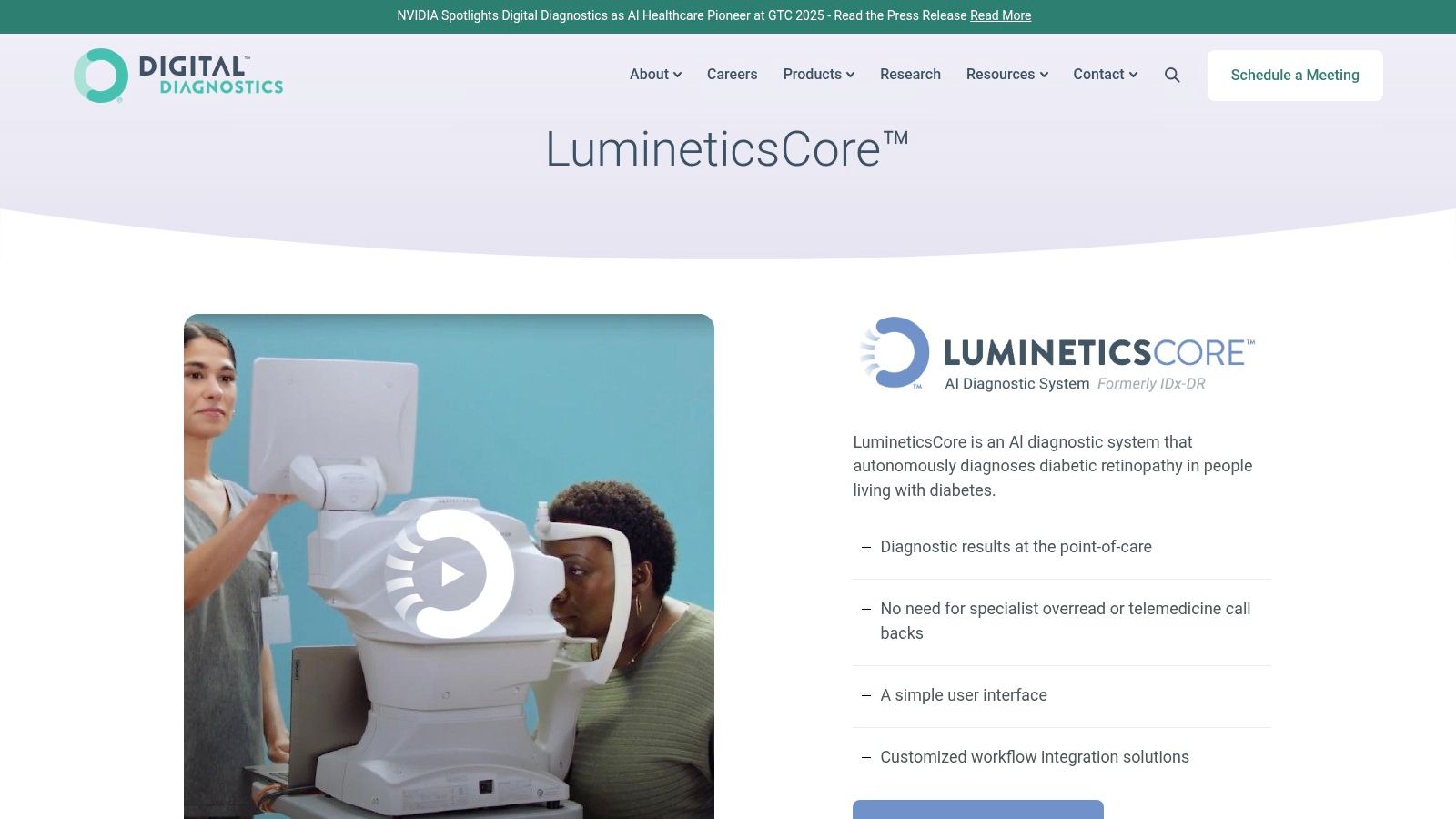
IDx-DR's core strength lies in its autonomous operation. Requiring minimal human intervention, the system integrates with existing medical imaging systems and delivers results in under a minute. This rapid turnaround time contributes to increased efficiency in primary care workflows, allowing physicians to address potential issues promptly. The system boasts high sensitivity (87.2%) and specificity (90.7%) rates, further reinforcing its diagnostic capabilities. For medical device manufacturers and healthcare technology companies, IDx-DR showcases the potential of AI-driven diagnostics to improve patient care and streamline clinical processes.
While specific pricing information isn't publicly available, potential implementers should anticipate initial implementation costs associated with acquiring the necessary hardware and software. The system requires specific Topcon fundus cameras (NW400, TRC-NW8F, or TRC-NW400) for image capture, which represents a technical requirement to consider during the planning phase. Hospital and clinic IT departments should be aware of these integration needs.
Compared to traditional diabetic retinopathy screening methods, which often involve referrals to specialists and longer wait times for results, IDx-DR offers a more immediate and accessible solution. This shift towards point-of-care diagnostics can be particularly beneficial in underserved communities or areas with limited access to specialists. This decentralized approach resonates with medtech startups and those exploring novel applications of DICOM communication and transfer, as it facilitates remote diagnosis and potentially reduces the need for extensive physical infrastructure.
For academic institutions and medical researchers focused on artificial intelligence medical devices, IDx-DR serves as a valuable case study in the development and implementation of autonomous AI diagnostic systems. Its success underscores the potential of AI to enhance diagnostic accuracy and efficiency in real-world clinical settings.
Implementation Tips:
- Training: Although minimal training is required to operate the system, ensure staff members are familiar with the image capture process using the compatible Topcon cameras and understand the interpretation of the results.
- Integration: Coordinate with your IT department to seamlessly integrate IDx-DR with your existing electronic health record (EHR) system.
- Patient Education: Educate patients about the benefits of this AI-powered screening tool and address any concerns they might have about automated diagnosis.
Pros:
- Increased accessibility of diabetic retinopathy screening in primary care settings
- Reduced burden on eye care specialists
- Enables earlier detection and treatment
- No need for specialized training to operate
Cons:
- Cannot detect all forms of eye disease
- Requires specific camera models for image capture
- May still need human verification in some cases
- Initial implementation costs can be significant
Website: https://www.digitaldiagnostics.com/products/idx-dr/
Despite some limitations, such as the need for specific camera models and the inability to detect all eye diseases, IDx-DR represents a significant advancement in artificial intelligence medical devices. Its autonomous diagnostic capabilities and potential to improve patient access to crucial screening make it a valuable tool in the fight against diabetic retinopathy.
3. Viz.ai: Revolutionizing Stroke Care with AI
Viz.ai stands as a prime example of how artificial intelligence is transforming medical devices and improving patient outcomes. This AI-powered stroke detection and triage platform is designed to drastically reduce the time-to-treatment for stroke patients, a critical factor in minimizing long-term disability. By analyzing CT scans for large vessel occlusions (LVOs) – a major cause of ischemic stroke – and automatically notifying specialists, Viz.ai synchronizes care and facilitates faster decision-making across the entire stroke team. This innovative approach to stroke care has been clinically validated and FDA-cleared, demonstrably reducing time-to-treatment by an average of 66 minutes, a significant improvement that can mean the difference between full recovery and permanent impairment. This makes Viz.ai a crucial tool in the arsenal against stroke, showcasing the potential of artificial intelligence medical devices to save lives and improve quality of life.

Viz.ai’s core functionality revolves around its ability to automatically detect LVOs and other stroke indicators in CT scans. The platform then sends real-time notifications to the entire care team, including neurologists, interventionalists, and emergency physicians, ensuring everyone is informed simultaneously. Mobile viewing of imaging allows specialists to quickly review cases from anywhere, further expediting the decision-making process. Seamless integration with existing hospital workflows and PACS (Picture Archiving and Communication Systems) ensures minimal disruption to established procedures while maximizing efficiency. Patient data synchronization across departments streamlines communication and care coordination.
For medical device manufacturers, healthcare technology companies, and medtech startups, Viz.ai serves as a compelling case study of successful AI integration within a critical care pathway. Researchers and scientists in academic institutions can learn from Viz.ai’s approach to image analysis and real-time clinical decision support. Hospital and clinic IT departments, as well as companies specializing in DICOM communication and transfer, can glean valuable insights into integrating AI-powered solutions into existing infrastructure.
Key Features and Benefits:
- Real-time notifications: Ensures immediate awareness of suspected stroke cases across the entire care team.
- Automatic LVO detection: Rapidly identifies critical blockages in blood vessels.
- Mobile image viewing: Facilitates rapid specialist review and consultation regardless of location.
- Data synchronization: Streamlines information sharing and care coordination.
- PACS integration: Minimizes disruption to established workflows.
- Continuously learning system: Viz.ai’s algorithms are constantly refined, leading to improved accuracy over time.
Pros:
- Significant reduction in time-to-treatment: Leads to better patient outcomes and reduced disability.
- Improved care team coordination: Facilitates faster decision-making and streamlined communication.
- Compatibility with existing infrastructure: Simplifies implementation and minimizes disruption.
Cons:
- Reliance on internet connectivity: A stable internet connection is essential for optimal performance.
- Workflow adjustments: Implementation requires some adjustments to existing hospital workflows.
- Subscription-based pricing: Adds ongoing costs to the healthcare system.
- Specialist verification: While Viz.ai automates detection, specialist verification is still required before treatment.
Implementation Tips:
- Thoroughly assess existing workflows and identify areas for optimization.
- Train all relevant staff on the platform's features and functionality.
- Ensure reliable internet connectivity throughout the hospital.
- Collaborate with Viz.ai’s implementation team to tailor the system to specific hospital needs.
While pricing information is not publicly available, Viz.ai operates on a subscription-based model. Further details regarding pricing and technical requirements can be obtained by contacting Viz.ai directly through their website: https://www.viz.ai/. Viz.ai’s impact on stroke care underscores the power of artificial intelligence medical devices to improve healthcare delivery. Its sophisticated algorithms, combined with seamless integration into existing systems, make it a powerful tool for hospitals and healthcare providers striving to provide the best possible care for stroke patients.
4. Butterfly iQ+
The Butterfly iQ+ represents a significant leap forward in accessible ultrasound technology, leveraging artificial intelligence to bring diagnostic imaging to a wider range of healthcare professionals. This handheld, AI-enabled device connects seamlessly with smartphones or tablets, effectively transforming them into portable, whole-body ultrasound systems. Unlike traditional ultrasound machines that rely on piezoelectric crystals, the Butterfly iQ+ utilizes semiconductor technology, resulting in a single-probe system capable of performing a variety of scans. This revolutionary approach, coupled with its AI-driven assistance, positions the Butterfly iQ+ as a game-changer in the realm of artificial intelligence medical devices.

This device is particularly valuable for point-of-care diagnostics, enabling clinicians in diverse settings to quickly assess patients. Its AI capabilities assist with image acquisition and interpretation, even automating calculations such as ejection fraction and bladder volume. These features empower healthcare providers with varying levels of ultrasound experience to utilize the technology effectively, expanding access to critical diagnostic information. For medical researchers and scientists, the Butterfly iQ+ offers a portable and versatile tool for data acquisition in various studies. Hospital and clinic IT departments can benefit from the device's seamless integration with existing mobile devices, simplifying deployment and reducing infrastructure costs. Medtech startups and those working with DICOM communication and transfer can leverage the Butterfly iQ+'s cloud storage and telemedicine capabilities to develop innovative solutions for remote diagnostics and collaborative care.
Practical Applications and Use Cases:
- Emergency Medicine: Rapid assessment of trauma, internal bleeding, and other urgent conditions.
- Primary Care: Point-of-care diagnostics for a range of conditions, from musculoskeletal injuries to cardiac assessments.
- Global Health: Expanding access to ultrasound in resource-limited settings.
- Veterinary Medicine: Portable and affordable imaging for animal care.
- Medical Education: Training tool for students learning ultrasound techniques.
Pricing and Technical Requirements:
The Butterfly iQ+ is significantly more affordable than traditional ultrasound machines, although specific pricing varies depending on the chosen subscription plan. It requires a compatible smartphone or tablet (iOS or Android) and the Butterfly iQ+ app. Advanced features, including cloud storage and certain AI tools, require a subscription.
Comparison with Similar Tools:
While other portable ultrasound devices exist, the Butterfly iQ+ distinguishes itself through its single-probe, whole-body scanning capabilities, AI-driven assistance, and relatively affordable price point.
Implementation/Setup Tips:
- Ensure your mobile device meets the minimum system requirements.
- Familiarize yourself with the Butterfly iQ+ app and its various features.
- Take advantage of the educational tutorials available within the app.
- Consider a suitable subscription plan based on your specific needs.
Pros:
- Significantly more affordable than traditional ultrasound machines.
- Highly portable for point-of-care diagnostics.
- No need to switch transducers between different scans.
- Regular software updates with new features and capabilities.
Cons:
- Image quality may not match high-end traditional ultrasound systems.
- Subscription required for advanced features.
- Battery life limitations for extensive use (approximately 2 hours of continuous scanning).
- Learning curve for those unfamiliar with ultrasound interpretation.
Website: https://www.butterflynetwork.com/
The Butterfly iQ+’s unique blend of portability, affordability, and AI-driven assistance makes it a valuable addition to any list of artificial intelligence medical devices. It democratizes access to vital diagnostic imaging, empowering healthcare providers and researchers alike with a powerful tool for improving patient care.
5. Zebra Medical Vision
Zebra Medical Vision, now integrated into Nanox.AI, stands out as a prominent player in the field of artificial intelligence medical devices. It offers a comprehensive suite of FDA-cleared AI-powered solutions designed to analyze medical images, assisting healthcare professionals in diagnosing a wide range of conditions. This makes it a valuable tool for various stakeholders in the healthcare industry, including medical device manufacturers, healthcare technology companies, medical researchers, and hospital IT departments. By leveraging the power of artificial intelligence, Zebra Medical Vision aims to improve the speed and accuracy of diagnoses, ultimately enhancing patient care.

The AI1 platform, Zebra Medical Vision's core offering, boasts a diverse array of algorithms capable of detecting various pathologies. These include breast cancer, vertebral fractures, coronary calcium, brain bleeds, and osteoporosis, utilizing data from CT scans, X-rays, and mammograms. This broad applicability across different imaging modalities and body areas sets it apart from more specialized artificial intelligence medical devices. The platform seamlessly integrates with existing Picture Archiving and Communication Systems (PACS) and worklist systems, minimizing disruption to established radiology workflows. This integration is crucial for practical implementation in busy hospital environments. The automated analysis provided by the AI1 platform prioritizes critical cases within worklists, allowing radiologists to focus their attention where it's needed most, potentially reducing burnout and improving overall efficiency. Beyond individual patient care, Zebra Medical Vision’s tools also offer population health screening capabilities, facilitating early detection and preventative care strategies. The system also boasts a continuous learning framework, receiving regular updates to enhance its performance and stay abreast of the latest medical advancements.
One of the significant advantages of Zebra Medical Vision is its comprehensive coverage of a wide range of medical conditions within a single platform. This consolidated approach simplifies procurement and implementation compared to deploying multiple specialized AI tools. The per-scan pricing model offers predictable costs, which is a crucial factor for budget planning within healthcare institutions. The system's ability to detect incidental findings, often missed in routine reviews, contributes to improved patient outcomes. For instance, while reviewing a chest X-ray for pneumonia, the AI might detect early signs of osteoporosis, prompting further investigation and potentially preventing future fractures.
However, Zebra Medical Vision, like other artificial intelligence medical devices, has certain limitations. The system's performance relies heavily on the quality of input images; noisy or low-resolution scans can impact the accuracy of the AI's analysis. Furthermore, the accuracy rates vary across different pathologies, meaning some conditions are detected more reliably than others. Implementation complexity can arise due to variations in hospital IT systems, requiring careful planning and configuration. Finally, regulatory approvals for specific algorithms differ between countries, which must be considered when deploying the technology internationally. Potential users should contact Nanox.AI directly for detailed pricing information and technical specifications relevant to their specific needs.
Despite these challenges, Zebra Medical Vision offers a powerful suite of tools for augmenting medical image analysis. Its comprehensive nature, integration capabilities, and focus on automation make it a valuable asset in the evolving landscape of artificial intelligence medical devices. For those seeking to improve efficiency, reduce radiologist workload, and enhance diagnostic accuracy, Zebra Medical Vision within the Nanox.AI ecosystem deserves serious consideration. You can explore their offerings further on their website: https://www.nanox.vision/nanox-ai.
6. AliveCor KardiaMobile 6L
The AliveCor KardiaMobile 6L stands out among artificial intelligence medical devices for its ability to provide comprehensive heart monitoring in a remarkably portable package. This FDA-cleared, AI-powered personal EKG device goes beyond basic heart rate tracking by detecting six distinct cardiac conditions, including atrial fibrillation, bradycardia, tachycardia, and more. This makes it a valuable tool for both patients with known heart conditions and individuals seeking proactive monitoring of their cardiovascular health. By leveraging artificial intelligence, the KardiaMobile 6L empowers users with immediate insights into their heart rhythm, enabling timely interventions and informed discussions with healthcare professionals. This focus on accessible and actionable cardiac data makes it a significant advancement in the field of artificial intelligence medical devices.
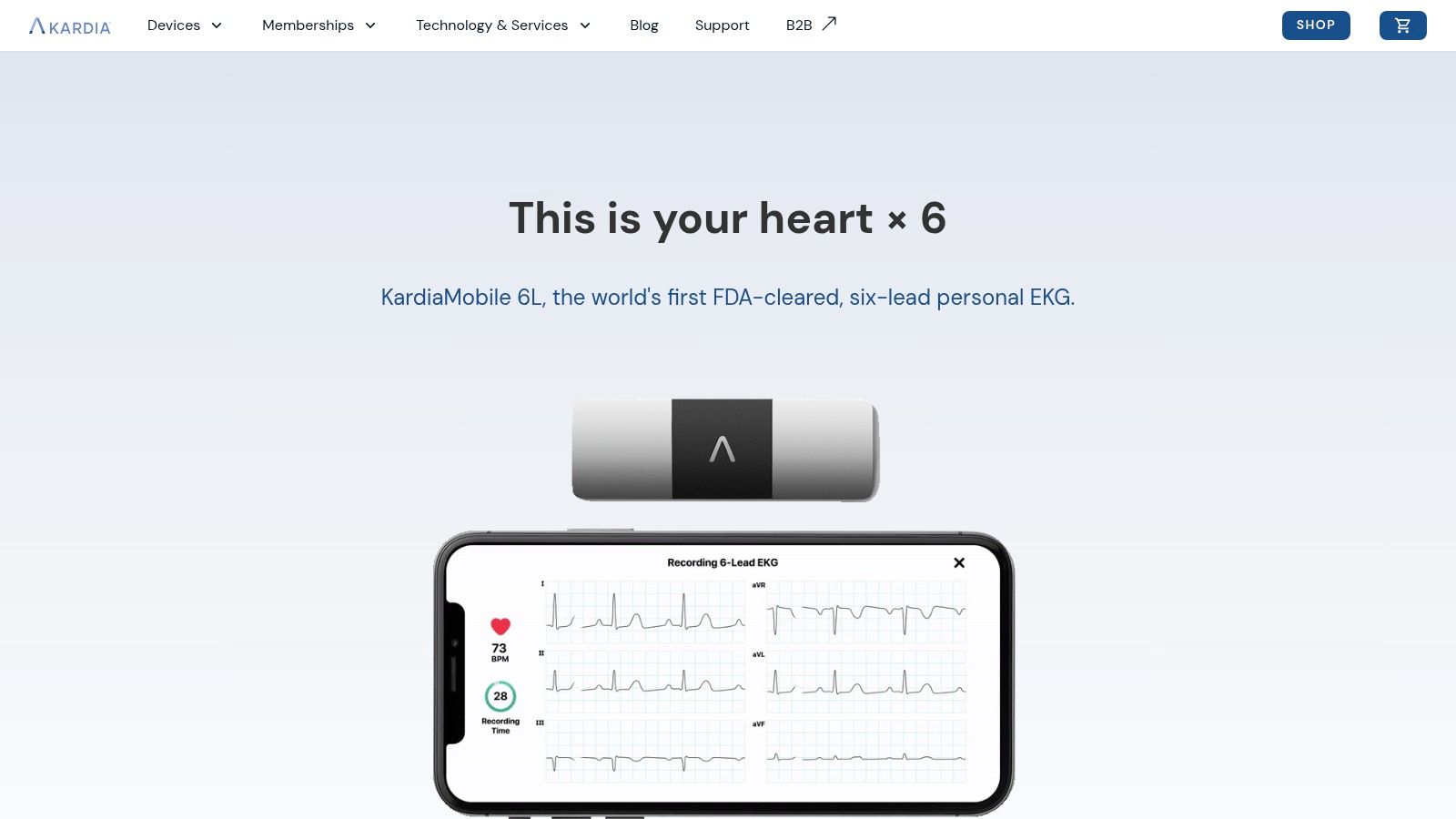
The device captures a medical-grade, six-lead EKG in just 30 seconds through a simple process of placing fingers and a leg on the device's electrodes. Unlike single-lead EKG devices, the six-lead configuration provides a more detailed view of the heart's electrical activity, leading to more accurate diagnoses. The accompanying app, compatible with most smartphones and tablets, utilizes sophisticated AI algorithms to analyze the EKG recording and deliver instant results. This real-time analysis facilitates early detection of potential heart issues, empowering users to seek prompt medical attention when necessary.
While the KardiaMobile 6L offers basic functionality without a subscription, some advanced features, such as detailed reports and personalized insights, require a paid subscription. The current price of the device is around $149, with subscription options varying in price depending on the features included. The device requires a compatible smartphone or tablet with Bluetooth connectivity to operate the app and view the results.
Implementation and Setup Tips:
- Download and install the Kardia app on your compatible smartphone or tablet.
- Create an account and follow the on-screen instructions to pair the KardiaMobile 6L with your device.
- Ensure your hands are clean and dry before taking an EKG recording.
- Follow the in-app guidance for proper electrode placement.
- Avoid movement during the 30-second recording period.
Comparison with Similar Tools:
Compared to other personal EKG devices, the KardiaMobile 6L differentiates itself with its six-lead capability, providing more comprehensive data than single-lead alternatives. This more detailed information is crucial for detecting a wider range of cardiac conditions and reducing the chance of misdiagnosis. Other devices may offer longer battery life or different subscription models, but the KardiaMobile 6L strikes a balance between affordability, functionality, and clinical accuracy.
Pros:
- Non-invasive heart monitoring for patients with known or suspected conditions.
- More comprehensive data capture compared to single-lead EKG devices.
- User-friendly, requiring no specialized medical training.
- Basic functionality accessible without a subscription.
Cons:
- Advanced features require a subscription.
- Requires a compatible smartphone or tablet.
- Not a substitute for professional medical evaluation and emergency services.
- May produce inconclusive results in some cases.
Website: https://www.alivecor.com/kardiamobile6l
The AliveCor KardiaMobile 6L represents a notable example of how artificial intelligence is transforming healthcare, bringing sophisticated diagnostic capabilities directly to the hands of individuals. Its portability, ease of use, and advanced AI-driven analysis make it a powerful tool for proactive heart health management and a valuable addition to the arsenal of artificial intelligence medical devices.
7. Aidoc: Comprehensive AI for Medical Imaging Analysis
Aidoc offers a comprehensive AI platform designed to support radiologists in their medical imaging analysis. This suite of decision-support solutions helps detect and flag critical conditions across various imaging modalities, including CT, X-ray, and MRI. By analyzing images in the background and notifying radiologists of critical findings, Aidoc’s always-on AI integrates seamlessly with existing workflows, enhancing efficiency and diagnostic accuracy. This makes it a valuable tool for any organization looking to leverage artificial intelligence medical devices to improve patient care and streamline radiology departments.
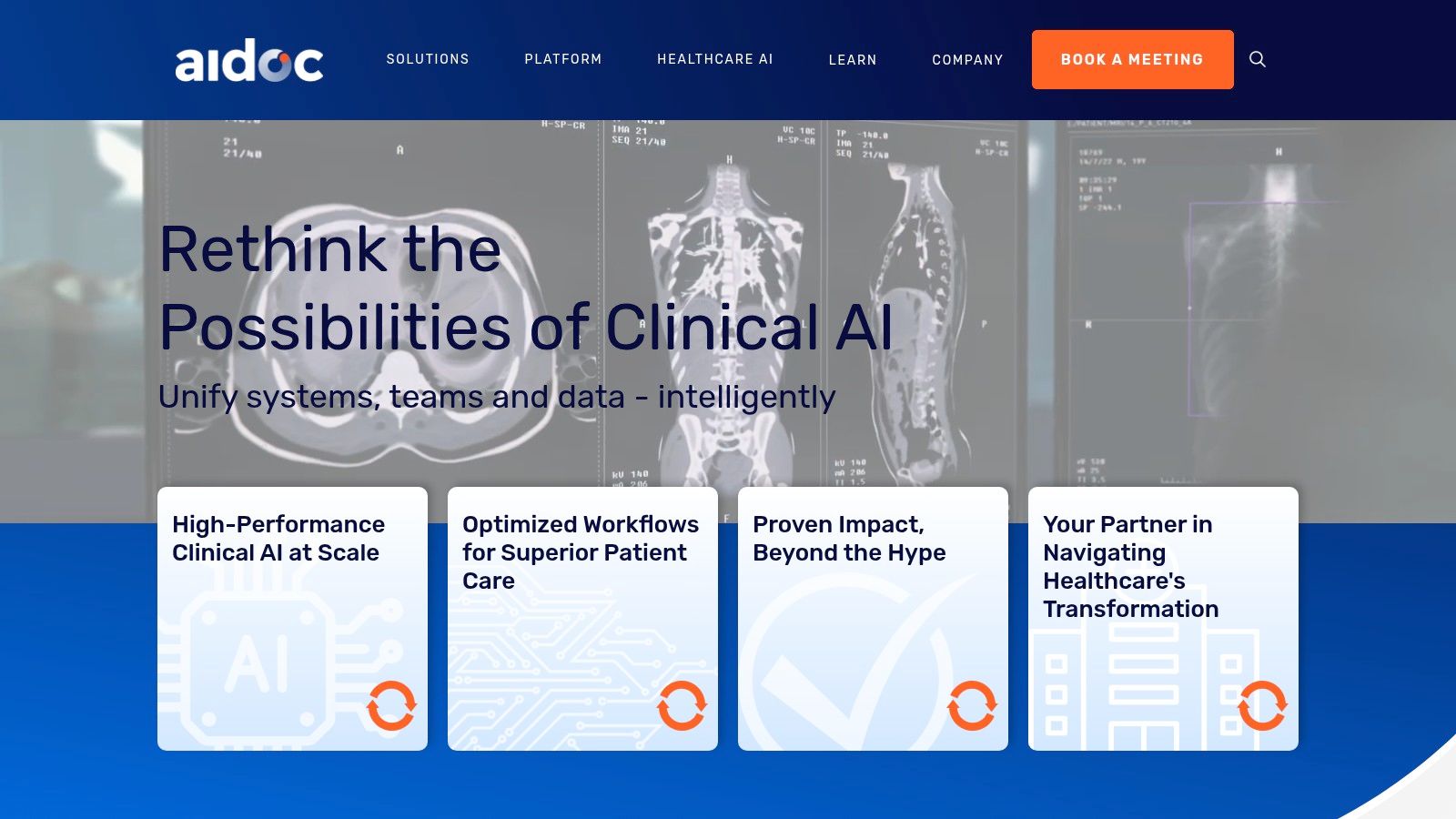
Aidoc’s strength lies in its ability to quickly and accurately identify a wide range of acute conditions. This includes intracranial hemorrhage, pulmonary embolism, cervical spine fractures, and more. The platform's ability to work across different imaging modalities allows for a consolidated approach to AI-powered image analysis, simplifying the integration of artificial intelligence medical devices into the radiology workflow. Its care coordination platform also facilitates streamlined communication between care teams, contributing to faster diagnosis and treatment.
This artificial intelligence medical device is particularly beneficial in time-sensitive scenarios, significantly reducing turnaround time for critical findings. By operating in parallel with radiologists, Aidoc avoids workflow disruptions, allowing radiologists to focus on complex cases while being alerted to urgent findings. The platform is adaptable to different hospital IT infrastructures, demonstrating its versatility across various healthcare settings. Aidoc has also received multiple FDA clearances for various pathologies, reinforcing its credibility and reliability as a diagnostic aid.
While Aidoc offers substantial advantages, it’s essential to consider the technical and financial aspects. The platform operates on a subscription-based pricing model, which requires ongoing operational expenditure. It also necessitates a robust IT infrastructure to handle the demands of AI processing. Performance can vary depending on image quality, highlighting the importance of high-quality image acquisition. Finally, implementation requires a training period for staff to effectively utilize the platform's features.
Key Features and Benefits:
- Real-Time Detection: Rapidly identifies and flags critical conditions, enabling prompt intervention.
- Seamless Integration: Integrates with existing PACS and worklist solutions for minimal disruption.
- Cross-Platform Compatibility: Works across various medical imaging vendors and modalities.
- Comprehensive Coverage: Addresses a wide range of pathologies across head, chest, abdomen, and spine.
- Care Coordination: Facilitates efficient communication and collaboration amongst care teams.
Pros:
- Reduces turnaround time for critical findings.
- Works in parallel with radiologists without disrupting workflow.
- Multiple FDA clearances for various pathologies.
- Adaptable to different hospital IT infrastructures.
Cons:
- Subscription-based pricing model.
- Requires robust IT infrastructure.
- Performance can vary depending on image quality.
- Implementation and training period required.
Implementation Tips:
- Thoroughly assess your current IT infrastructure to ensure compatibility and optimal performance.
- Dedicate time for staff training to maximize the platform's effectiveness.
- Evaluate your specific needs and choose the Aidoc modules that best align with your clinical focus.
- Collaborate with Aidoc's support team throughout the implementation process for guidance and assistance.
Aidoc deserves a place on this list due to its comprehensive AI-powered approach to medical imaging analysis. Its ability to seamlessly integrate with existing workflows, reduce turnaround time, and improve diagnostic accuracy makes it a valuable asset in modern radiology departments. By providing timely and accurate insights, Aidoc empowers radiologists to deliver better patient care and improve overall healthcare outcomes. For more information, visit the Aidoc website.
8. Caption Health (Caption AI)
Caption Health (Caption AI) is revolutionizing cardiac ultrasound by empowering healthcare practitioners with limited ultrasound experience to capture diagnostic-quality images. This FDA-cleared, AI-guided ultrasound system leverages the power of artificial intelligence medical devices to provide real-time guidance, automated quality assessment, and interpretation assistance. This makes it a valuable tool for various stakeholders in the medical field, including medical device manufacturers, healthcare technology companies, and researchers. By using deep learning algorithms, Caption AI offers instructions, feedback, and automated measurements, effectively simulating the presence of an expert sonographer guiding the user through the examination. This positions Caption AI as a significant advancement in point-of-care diagnostics and a key player in the growing field of artificial intelligence medical devices.
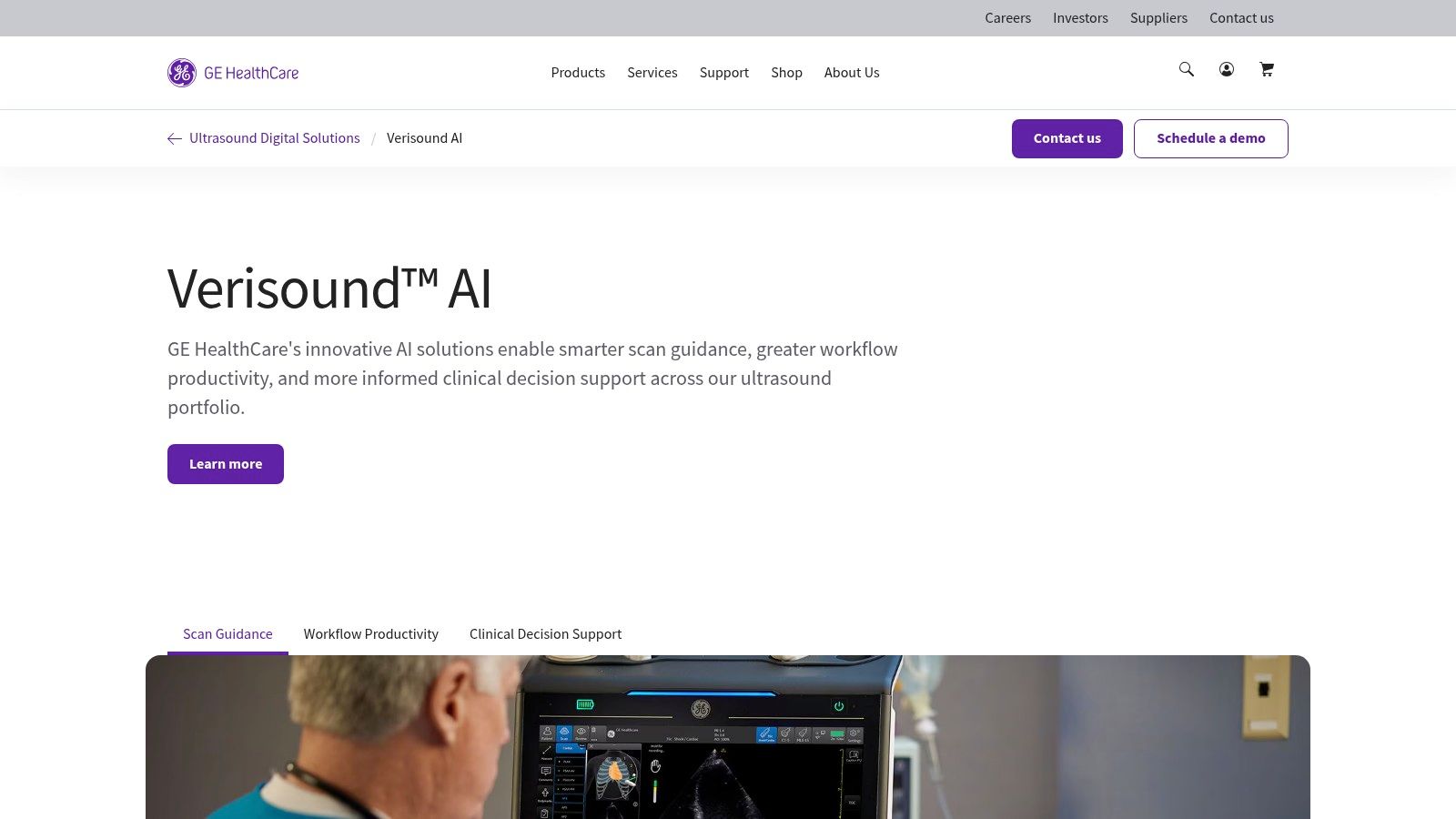
Caption AI's standout features include real-time AI guidance for probe positioning and adjustment, ensuring accurate image acquisition. The software automatically assesses the quality of captured images and calculates the ejection fraction, a key metric of heart function. It guides users through a step-by-step protocol for a comprehensive cardiac assessment, ensuring consistent and thorough examinations. Furthermore, its compatibility with several ultrasound machines makes it a versatile solution for various clinical settings. This interoperability is particularly important for hospital and clinic IT departments seeking to integrate AI-driven solutions into existing infrastructure. For medtech startups and those involved in DICOM communication and transfer, Caption AI represents a powerful platform for developing and deploying innovative imaging solutions.
While specific pricing information isn't publicly available, it's safe to assume an initial investment is required for the software license and potentially for compatible ultrasound hardware if not already available. Implementation involves training staff on the software, which, thanks to the intuitive AI guidance, is significantly less time-consuming than traditional ultrasound training. This reduced training time translates to cost savings and faster deployment, making it an attractive option for resource-constrained environments.
Compared to traditional ultrasound procedures requiring specialized sonographers, Caption AI democratizes access to cardiac assessments, particularly in point-of-care settings. This is a crucial advantage for expanding access to care, especially in remote or underserved areas. While Caption AI currently focuses on cardiac applications, its underlying technology holds the potential for expansion into other areas of ultrasound imaging, further solidifying its position in the artificial intelligence medical devices landscape.
Pros:
- Enables non-specialists to perform cardiac ultrasounds
- Reduces training time for basic ultrasound competency
- Increases access to cardiac assessment, particularly in point-of-care settings
- Provides consistent results across different users
Cons:
- Currently limited to cardiac applications
- Requires compatible ultrasound hardware
- Initial cost investment
- Some advanced assessments still require specialist expertise
Caption Health (Caption AI) earns its place on this list due to its innovative application of artificial intelligence in medical imaging. Its ability to empower non-specialists to perform cardiac ultrasounds has far-reaching implications for improving access to care and potentially transforming how cardiac assessments are conducted in the future. You can learn more about Caption AI by visiting their website: https://captionhealth.com/
9. Arterys: Cloud-Powered AI for Medical Imaging
Arterys stands out as a leading provider of cloud-native artificial intelligence medical devices, offering a comprehensive platform for enhanced medical image interpretation and quantification. This platform proves invaluable for radiologists and cardiologists working with various imaging modalities, streamlining workflows and enhancing diagnostic accuracy. By leveraging the power of deep learning, Arterys automates time-consuming tasks like measurements and anatomical segmentations, allowing medical professionals to focus on critical decision-making. This innovative approach to artificial intelligence medical devices positions Arterys as a valuable tool in modern healthcare settings.
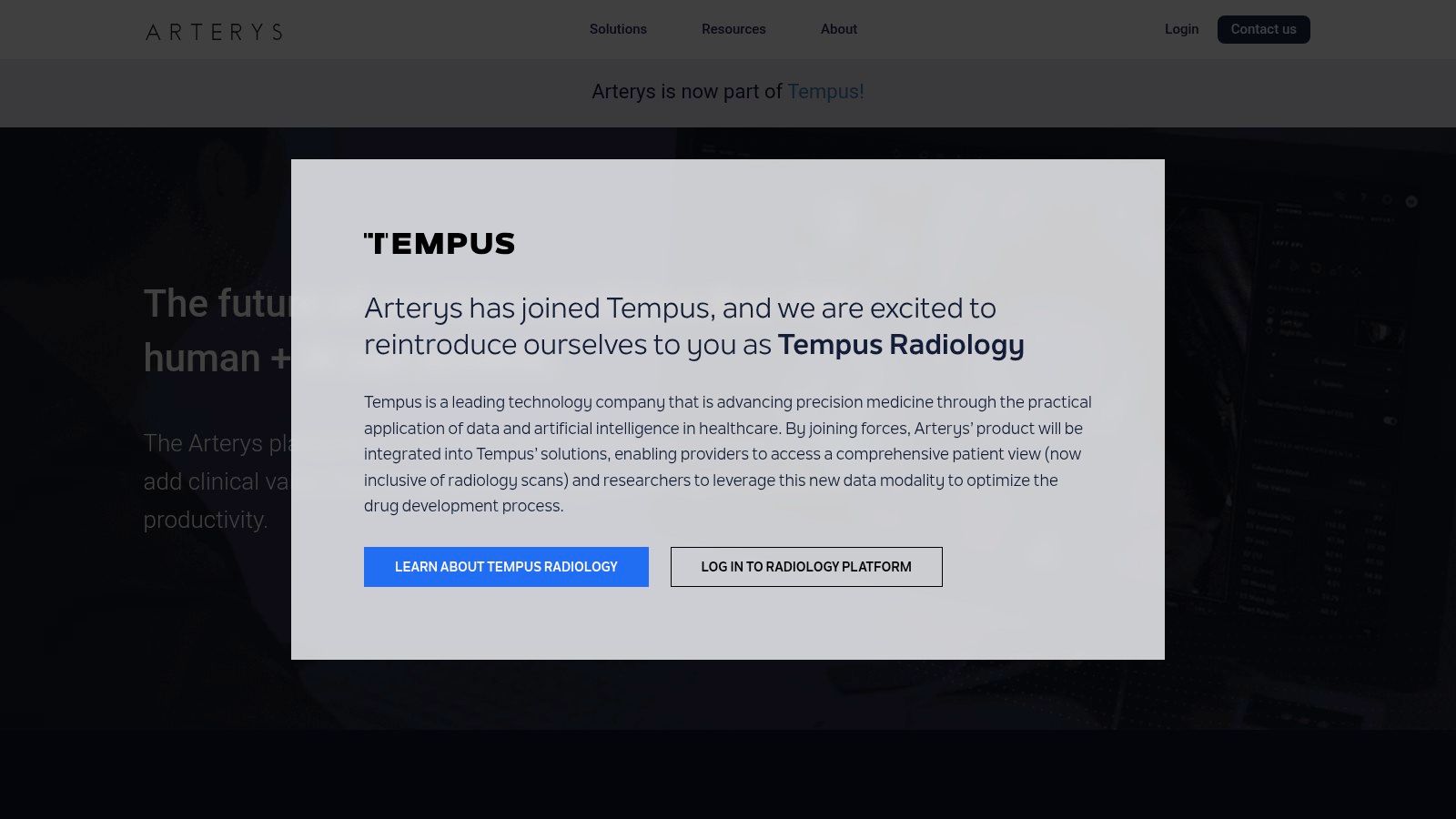
Arterys distinguishes itself through its cloud-based architecture, eliminating the need for local computational resources. This means any device with a web browser can access the platform, offering unparalleled flexibility for users. Its multi-modality support, encompassing MRI, CT, and X-ray, caters to diverse diagnostic needs. The platform includes FDA-cleared applications for cardiac MRI, lung CT, and liver MRI analysis, providing clinicians with reliable and validated AI-powered insights. Further enhancing its utility are collaborative tools facilitating multi-disciplinary team reviews, ensuring seamless communication and informed decision-making. The HIPAA-compliant cloud infrastructure, complete with de-identification features, prioritizes patient data security and regulatory compliance.
Practical Applications and Use Cases:
- Cardiac MRI Analysis: Automated quantification of ventricular volumes, ejection fraction, and myocardial mass, improving the efficiency and accuracy of cardiac function assessments.
- Lung CT Analysis: Automated nodule detection and characterization, assisting in early lung cancer diagnosis and treatment planning.
- Liver MRI Analysis: Automated liver segmentation and volumetry, facilitating the assessment of liver disease and treatment response.
- Collaborative Diagnosis: Facilitates multi-disciplinary team reviews of medical images, improving diagnostic accuracy and communication.
Technical Requirements and Pricing:
Arterys requires a reliable internet connection as it operates entirely within a cloud environment. The platform adopts a subscription-based pricing model, although specific details are available upon request. Processing times can vary based on internet speed and server load.
Implementation and Setup Tips:
Integration with existing PACS and EMR systems streamlines workflow incorporation. While the platform is generally user-friendly, allocating time for training ensures teams can fully utilize its advanced features.
Pros:
- No local computational requirements, simplifying deployment and maintenance.
- Continuous updates to AI models without requiring local installation.
- Comprehensive suite of applications across various body regions.
- Seamless integration with existing PACS and EMR systems.
Cons:
- Dependence on reliable internet connectivity.
- Subscription-based pricing model may present budgetary considerations.
- Processing time can fluctuate based on internet speed and server load.
- A learning curve exists for maximizing platform functionality.
Comparison with Similar Tools:
While other artificial intelligence medical devices exist, Arterys’ cloud-native approach, multi-modality support, and focus on automated quantification differentiate it. Its comprehensive suite of FDA-cleared applications further solidifies its position as a leader in the field.
Website: https://www.arterys.com/
Arterys deserves its place on this list due to its innovative cloud-based approach, comprehensive functionality, and commitment to improving the efficiency and accuracy of medical image interpretation. Its FDA-cleared applications and integration capabilities make it a valuable asset for any institution looking to leverage the power of artificial intelligence in medical imaging.
10. Subtle Medical (SubtlePET & SubtleMR)
Subtle Medical contributes significantly to the advancement of artificial intelligence medical devices by offering AI-powered solutions that enhance medical imaging workflows. Their FDA-cleared products, SubtlePET and SubtleMR, leverage deep learning algorithms to denoise and improve image quality for Positron Emission Tomography (PET) and Magnetic Resonance Imaging (MRI) scans. This innovative approach allows for scans to be taken with reduced radiation dose (in the case of PET) or shortened scan times for both modalities, ultimately benefiting both patients and healthcare providers. This technology is particularly relevant for medical device manufacturers, healthcare technology companies, medical researchers, and hospital IT departments seeking to integrate cutting-edge AI solutions into their imaging pipelines.
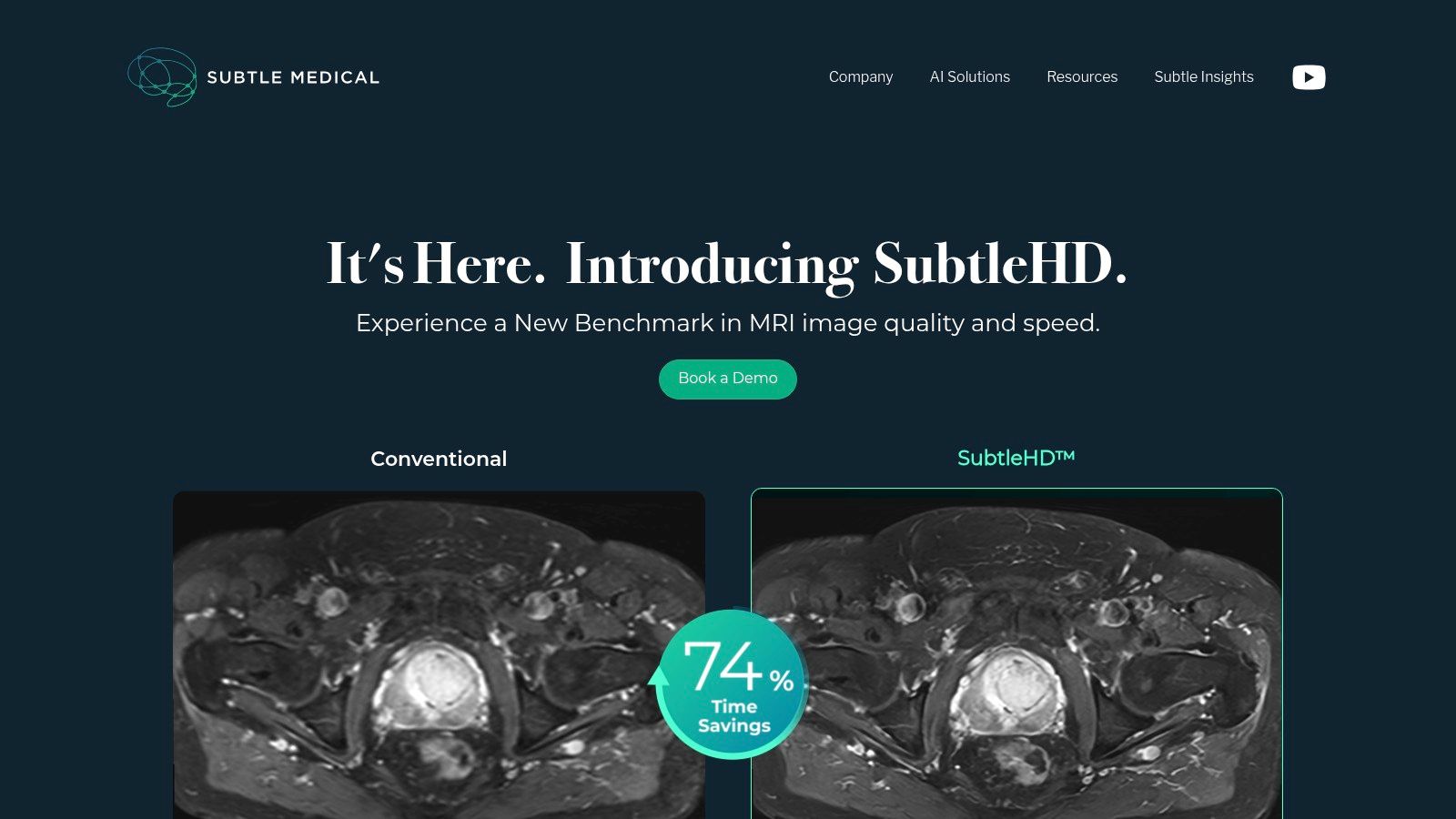
SubtlePET and SubtleMR address critical challenges in medical imaging. By improving image quality from faster, lower-dose scans, these tools empower healthcare providers to improve patient comfort and increase scanner throughput without sacrificing diagnostic quality. For PET imaging, this translates to a significant reduction in radiation exposure, aligning with the growing emphasis on patient safety. The vendor-neutral compatibility of these solutions ensures seamless integration with existing scanners and PACS systems, minimizing disruption to established workflows. This is a major advantage for institutions looking to adopt AI without significant capital expenditure on new equipment. For medtech startups and DICOM communication and transfer companies, Subtle Medical's products offer opportunities for collaboration and integration within their own solutions.
Features and Benefits:
- Improved Image Quality: Deep learning algorithms denoise images acquired with faster scan times and lower doses, maintaining diagnostic quality.
- PET Dose Reduction: Enables dose reduction of up to 75%, minimizing patient radiation exposure.
- MRI Scan Time Reduction: Reduces MRI scan times by up to 60%, increasing patient comfort and scanner efficiency.
- Vendor-Neutral Compatibility: Works with existing scanners from different manufacturers, simplifying implementation.
- Seamless PACS Integration: Integrates seamlessly with existing Picture Archiving and Communication Systems, minimizing workflow disruption.
Pros:
- Enhanced Patient Experience: Shorter scan times improve patient comfort and reduce anxiety.
- Increased Operational Efficiency: Higher throughput and reduced scan times optimize scanner utilization.
- Lower Radiation Exposure: Significantly reduces radiation dose associated with PET scans.
- Simplified Implementation: No change to existing workflows or equipment is required.
Cons:
- Initial Implementation Costs: While no new equipment is required, software licensing and integration involve upfront costs.
- Validation in Specific Clinical Contexts: Thorough validation may be required for specific clinical applications.
- Performance Dependence: Performance may vary depending on the original scan parameters.
- Subscription Model: Ongoing costs are associated with the subscription-based pricing model. Pricing is not publicly available and requires contacting Subtle Medical directly.
Implementation and Setup Tips:
Contact Subtle Medical directly for detailed information about implementation, technical requirements, and pricing. They offer support for integrating their solutions into existing workflows. Piloting the software in a specific clinical context before full-scale deployment is recommended to assess its effectiveness and optimize parameters for your specific needs.
Subtle Medical's AI-powered solutions deserve a place on this list of artificial intelligence medical devices because they represent a practical application of deep learning to improve medical imaging. By enabling faster, lower-dose scans without compromising image quality, SubtlePET and SubtleMR offer tangible benefits for patients, healthcare providers, and institutions. While factors such as initial implementation costs and the subscription-based model should be considered, the potential for improved patient care and operational efficiency makes these tools a valuable addition to the evolving landscape of AI in medicine. You can learn more by visiting their website: https://subtlemedical.com/
AI Medical Devices: 10-Device Feature Comparison
| Solution | Core Features ★ | Target Audience 👥 | Unique Selling Points ✨ | Pricing/Value 💰 |
|---|---|---|---|---|
| PYCAD 🏆 | End-to-end AI: data handling, model training, deployment | Med device makers, hospitals, academia | 10+ projects, custom solutions, enhanced diagnostics | Consultation required, competitive value |
| IDx-DR | Autonomous retinal analysis, results in <1 minute | Primary care, diabetic screening | FDA-approved, minimal training | High initial cost |
| Viz.ai | CT stroke detection, real-time alerts | Stroke centers, hospitals | 66-min faster treatment, seamless workflow integration | Subscription-based |
| Butterfly iQ+ | Handheld ultrasound with AI-guided imaging | Clinicians, point-of-care diagnostics | Portable, all-in-one probe, affordable alternative | Affordable core; subscriptions for extras |
| Zebra Medical Vision | Multi-modal AI analysis with automated worklist integration | Radiology departments, hospitals | Wide condition coverage, per-scan pricing | Per-scan model |
| AliveCor KardiaMobile 6L | 6-lead EKG with AI rhythm analysis, 30-second recording | Cardiology clinics, personal monitoring | Medical-grade, pocket-sized, no basic subscription | Basic free; advanced subscription |
| Aidoc | Real-time detection across multiple modalities | Radiologists, hospitals | Seamless PACS integration, multiple FDA clearances | Subscription-based |
| Caption Health | AI-guided cardiac ultrasound with real-time quality assessment | Non-specialists, point-of-care cardiac centers | Step-by-step guidance, reduced training time | Initial cost plus subscription |
| Arterys | Cloud-native multi-modality imaging analysis with automated segmentation | Radiologists, cardiologists, hospitals | No local compute, continuous model updates | Subscription-based |
| Subtle Medical | AI-enhanced PET/MRI imaging, reduced scan times and radiation doses | Hospitals, radiology centers | Improved image quality, increased throughput, patient comfort | Subscription & implementation cost |
Embracing the AI Revolution in Medical Devices
This article explored ten cutting-edge artificial intelligence medical devices, from diagnostic tools like IDx-DR for diabetic retinopathy and Viz.ai for stroke detection to innovative imaging solutions like Butterfly iQ+ and Caption Health, and analysis platforms like Zebra Medical Vision and Arterys. We've also looked at tools that empower patients, such as the AliveCor KardiaMobile 6L for heart health monitoring, and those that enhance image quality and speed like Subtle Medical's SubtlePET and SubtleMR. These tools demonstrate the transformative power of AI in healthcare, offering improved accuracy, speed, and efficiency across various medical specialties.
Key takeaways include the potential for artificial intelligence medical devices to significantly reduce diagnostic errors, improve workflow efficiency in busy clinical settings, and enable more personalized treatment plans. When considering implementing AI-powered medical devices, it's crucial to evaluate factors such as regulatory compliance, data security, integration with existing systems, and the specific clinical needs of your institution. Choosing the right tool requires careful consideration of its intended use, the level of clinical validation, and the available support and training resources.
The future of healthcare is undeniably intertwined with the continued development and adoption of artificial intelligence medical devices. These technologies hold the promise of not only improving the quality of care but also expanding access to essential diagnostic and treatment services, ultimately leading to better patient outcomes. As we move forward, embracing these advancements will be crucial for staying at the forefront of medical innovation.
Looking to build your own robust and compliant artificial intelligence medical devices? PYCAD offers a specialized platform for developing and deploying AI solutions in healthcare. Explore the possibilities and accelerate your AI medical device development journey by visiting PYCAD.
